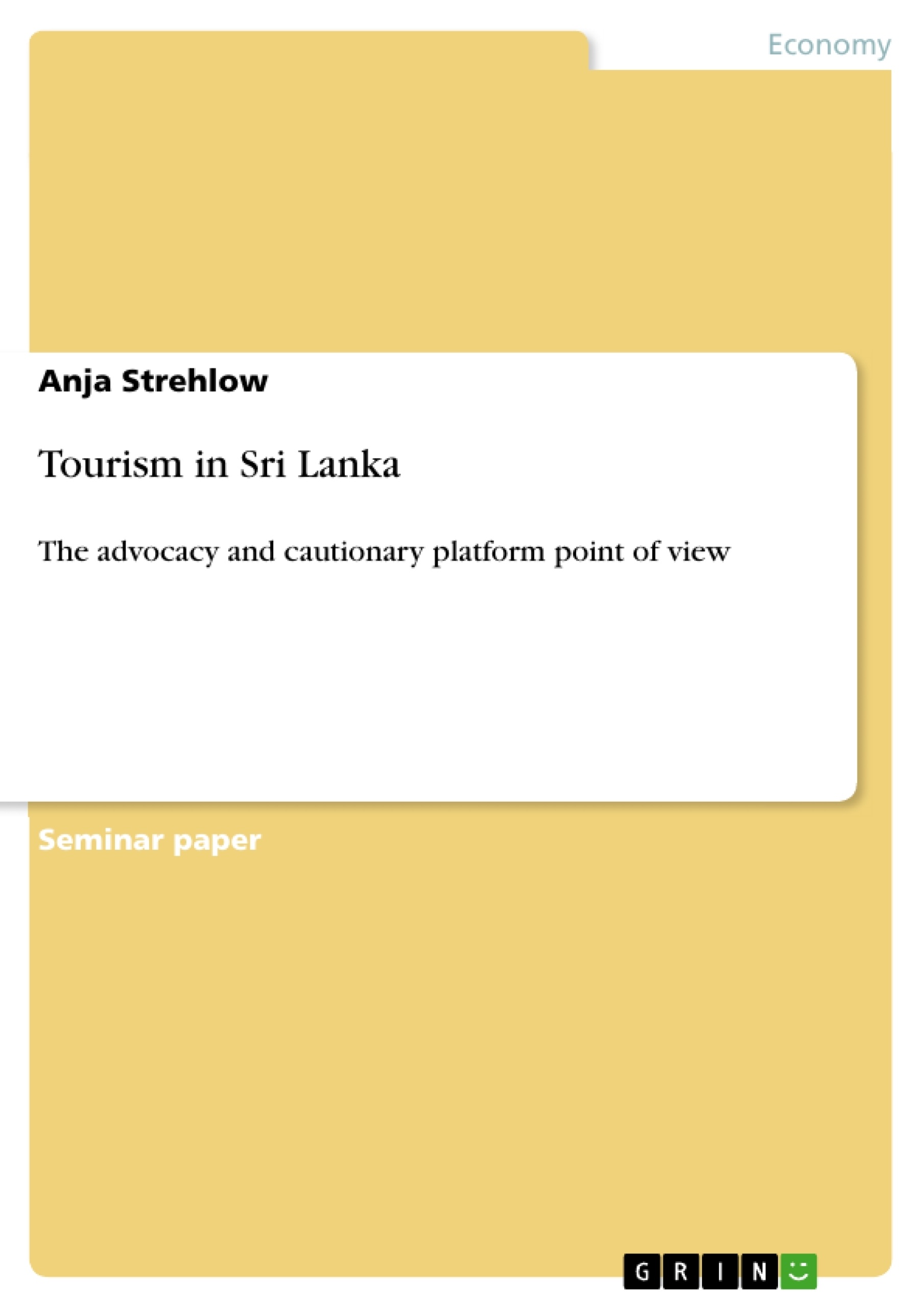Whether Tourism is ‘good’ or ‘bad’ has been a topic of discussion and disagreement for several decades. There are two opposing, rather radical points of view: the advocacy platform and the cautionary platform. In this essay both platforms will be explained and illustrated on the example of Sri Lanka.
Table of Contents
- Introduction
- The advocacy platform
- Cross-cultural understanding and peace
- Incentive to preserve local culture and heritage
- Social stability through positive economic outcomes
- The cautionary platform
- Commodification
Objectives and Key Themes
This essay aims to explore the contrasting perspectives on tourism's impact, specifically examining whether it is beneficial or detrimental. It uses Sri Lanka as a case study to illustrate the "advocacy" and "cautionary" platforms regarding tourism development.
- The economic impact of tourism on Sri Lanka
- The socio-cultural benefits and drawbacks of tourism
- The role of tourism in preserving cultural heritage
- The potential for tourism to promote peace and cross-cultural understanding
- The challenges of managing tourism sustainably in a developing nation
Chapter Summaries
Introduction: This introductory section establishes the central debate surrounding tourism's impact – whether it is ultimately "good" or "bad." It introduces the two opposing viewpoints: the advocacy platform, which emphasizes the benefits of tourism, and the cautionary platform, which highlights its potential negative consequences. The essay uses Sri Lanka, a country heavily reliant on tourism, as a case study to examine these contrasting perspectives. The historical context of Sri Lanka, including its ethnic tensions and economic reliance on the service sector, particularly tourism, is presented to set the stage for the subsequent analysis.
The advocacy platform: This section details the arguments put forth by proponents of tourism development. Originating in the 1950s and 60s, this perspective emphasizes the economic advantages and socio-cultural benefits of tourism. Key arguments include the promotion of cross-cultural understanding and peace through increased interaction between tourists and locals; the incentive for preserving local culture and heritage sites to attract tourists and generate revenue; and the stimulation of the local economy through job creation and new markets, leading to social stability and poverty alleviation. Examples of Sri Lankan government initiatives supporting tourism, such as the International Tourism Year of 1967 and the Cultural Triangle Development project, are used to illustrate the advocacy platform's practical application. The section also addresses counterarguments regarding authenticity and cultural change, emphasizing that cultural change is a continuous process and that tourism's impact should be viewed in the context of other influential factors.
The cautionary platform: This section presents the counterarguments raised by those critical of unfettered tourism development. Emerging in the late 1960s and 70s, this perspective highlights the negative social and cultural impacts of mass tourism. The main concerns center around "commodification," where traditional cultural practices are modified or exploited to cater to tourist preferences, potentially leading to the erosion of authenticity and cultural integrity. The section briefly introduces other concerns like the demonstration effect, crime, and the overall perception of tourism's impact on a community, which will be explored in more detail later.
Keywords
Tourism, Sri Lanka, advocacy platform, cautionary platform, sustainable tourism, cultural heritage, economic development, socio-cultural impacts, commodification, cross-cultural understanding.
Frequently Asked Questions: A Comprehensive Language Preview
What is the overall purpose of this document?
This document provides a comprehensive preview of a language essay, including the table of contents, objectives, key themes, chapter summaries, and keywords. It offers a structured overview of the arguments and analysis presented in the full essay.
What is the central theme explored in the essay?
The essay explores the contrasting perspectives on tourism's impact, specifically examining whether tourism in Sri Lanka is ultimately beneficial or detrimental. It analyzes the "advocacy" and "cautionary" platforms regarding tourism development.
What are the key platforms discussed regarding tourism's impact?
The essay presents two main platforms: The advocacy platform, which emphasizes the economic and socio-cultural benefits of tourism, and the cautionary platform, which highlights the potential negative consequences, primarily focusing on commodification.
What are the main arguments of the advocacy platform?
The advocacy platform argues that tourism promotes cross-cultural understanding and peace, incentivizes the preservation of local culture and heritage, and stimulates the local economy, leading to social stability and poverty alleviation. It supports this with examples of Sri Lankan government initiatives promoting tourism.
What are the main arguments of the cautionary platform?
The cautionary platform primarily focuses on the negative aspect of "commodification," where cultural practices are modified or exploited to cater to tourist preferences, potentially leading to the erosion of authenticity and cultural integrity. It also briefly touches upon other concerns like the demonstration effect and crime.
What is the role of Sri Lanka in this essay?
Sri Lanka serves as a case study to illustrate the contrasting perspectives on tourism's impact. Its historical context, including ethnic tensions and economic reliance on tourism, provides a relevant backdrop for the analysis.
What are the key themes explored in the essay?
The key themes include the economic impact of tourism on Sri Lanka, socio-cultural benefits and drawbacks, the role of tourism in preserving cultural heritage, tourism's potential to promote peace and cross-cultural understanding, and the challenges of managing tourism sustainably in a developing nation.
What are the chapter summaries included in the preview?
The preview includes summaries for the Introduction, The Advocacy Platform, and The Cautionary Platform chapters. The Introduction sets the stage by outlining the central debate and introducing the two opposing viewpoints. The Advocacy Platform details the arguments supporting tourism's benefits, while the Cautionary Platform presents the counterarguments emphasizing potential negative consequences.
What are the keywords associated with this essay?
The keywords include: Tourism, Sri Lanka, advocacy platform, cautionary platform, sustainable tourism, cultural heritage, economic development, socio-cultural impacts, commodification, and cross-cultural understanding.
Where can I find more information?
This document is a preview; the full essay provides a more in-depth exploration of the themes and arguments discussed here.
- Quote paper
- Anja Strehlow (Author), 2006, Tourism in Sri Lanka, Munich, GRIN Verlag, https://www.grin.com/document/132331



